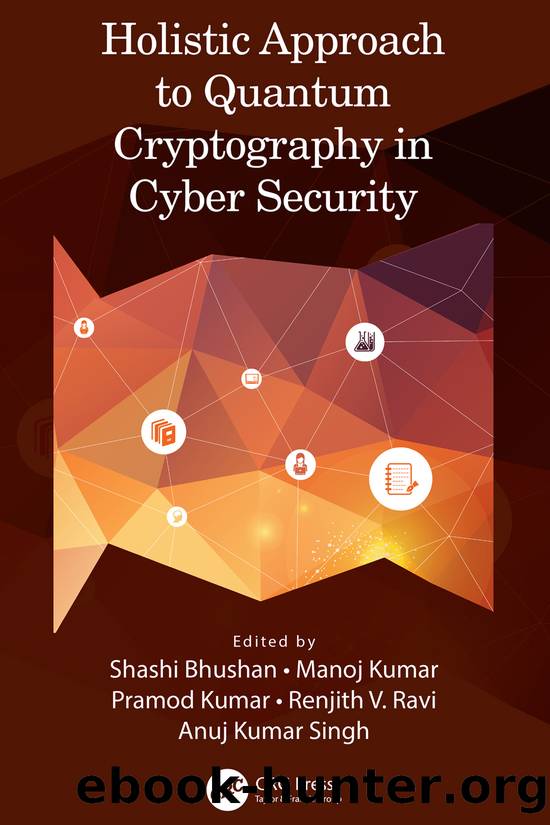Holistic Approach to Quantum Cryptography in Cyber Security by Shashi Bhushan;Manoj Kumar;Pramod Kumar;Renjith V. Ravi;Anuj Kumar Singh;

Author:Shashi Bhushan;Manoj Kumar;Pramod Kumar;Renjith V. Ravi;Anuj Kumar Singh;
Language: eng
Format: mobi, epub
ISBN: 9781000614503
Publisher: CRC Press (Unlimited)
Published: 2022-06-13T00:00:00+00:00
Swati Goel and Monika Agrawal
DOI: 10.1201/9781003296034-7
CONTENTS
7.1 Introduction: Background
7.1.1 Purposes of Research
7.1.2 Methodology of Research
7.2 Overview of Intrusion Detection Techniques
7.3 Methodology
7.3.1 Pre-process Data
7.3.2 Clustering
7.3.2.1 PAM Algorithm
7.3.3 Classification
7.3.4 Evaluation Method
7.4 Research Overview
7.4.1 Problem Definition
7.4.2 Experimentation and Results
7.4.3 Contribution and Impact
7.5 Conclusion
7.6 Future Scope of Work
References
7.1 INTRODUCTION: BACKGROUND
Since the 1960s, the internet has served as a vital link between individuals, businesses, and organizations. Peopleâs geographical barriers have been broken down by the internet, which has provided them with a reliable, productive, and low-cost means of communication.
Nowadays, it appears that things are going to be different in the internet space as an outcome of the introduction of smart things that can generate and communicate data over the web in a manner like human beings. The internet of things (IoT) is a new stream to be explored, and it is a system that has the ability to transform our lives. IoT can be thought of as a two-component technology.
Any object which can collect data about its surroundings or for itself is referred to as a âThing.â Depending on the objectâs type, intelligence, and capabilities, it can analyze and interact intelligently with connected devices through the internet.
In the internet of things, communication does not take place only among IoT things. It further extends focusing on humans in such a manner which makes life simpler, healthier, and more enjoyable. There has been a lot of research into how IoT can help to improvise human health by remotely assessing their health and removing the requirement for frequent hospital visits. The Internet of Things (IoT) is widespread and is used in almost every aspect of our lives. Governments all over the world are implementing IoT in order to gather raw data through various sectors and improve facilities in areas such as health, transportation, security, and development [1].
Attacks on IoT are becoming more common as it becomes more widespread. Statistics show that the number of devices attached to the IoT framework has increased drastically in recent times. The overall global market for IoT is expected to reach around $1.6 trillion by 2025 as per a forecasting report.
Medical, geopolitical, environmental, governmental, or a similar type of dataset with varying significance may be included. Hence, itâs critical to protect these types of information and devices [2].
Physical and logical controls can be used to keep an information system secure. Hardware devices are prevented from attackers using various physical controls.
Intrusion detection and prevention mechanisms [3] are tools for detecting familiar attacks or abnormalities in computer networks. When an intrusion prevention system detects or matches an attack signature or anomaly, it takes predetermined and systemic steps to stop the attack. Detection of anomalies can be done based on signature or on anomalies. In case of signature-based techniques, known attacks are detected by observing patterns in data stored in a systemâs memory or in network traffic. Unknown attacks are detected using anomaly-based detection, which performs a comparative analysis of the objects, entire system, or traffic. Attackers are now capable of creating malware which can change its structure while in execution in order to avoid detection.
Download
Holistic Approach to Quantum Cryptography in Cyber Security by Shashi Bhushan;Manoj Kumar;Pramod Kumar;Renjith V. Ravi;Anuj Kumar Singh;.epub
This site does not store any files on its server. We only index and link to content provided by other sites. Please contact the content providers to delete copyright contents if any and email us, we'll remove relevant links or contents immediately.
Whiskies Galore by Ian Buxton(41524)
Introduction to Aircraft Design (Cambridge Aerospace Series) by John P. Fielding(32882)
Small Unmanned Fixed-wing Aircraft Design by Andrew J. Keane Andras Sobester James P. Scanlan & András Sóbester & James P. Scanlan(32569)
Aircraft Design of WWII: A Sketchbook by Lockheed Aircraft Corporation(32131)
Craft Beer for the Homebrewer by Michael Agnew(17927)
Turbulence by E. J. Noyes(7690)
The Complete Stick Figure Physics Tutorials by Allen Sarah(7135)
The Institute by Stephen King(6798)
Kaplan MCAT General Chemistry Review by Kaplan(6587)
The Thirst by Nesbo Jo(6432)
Bad Blood by John Carreyrou(6270)
Modelling of Convective Heat and Mass Transfer in Rotating Flows by Igor V. Shevchuk(6219)
Learning SQL by Alan Beaulieu(6027)
Weapons of Math Destruction by Cathy O'Neil(5820)
Man-made Catastrophes and Risk Information Concealment by Dmitry Chernov & Didier Sornette(5641)
Permanent Record by Edward Snowden(5535)
Digital Minimalism by Cal Newport;(5384)
Life 3.0: Being Human in the Age of Artificial Intelligence by Tegmark Max(5181)
iGen by Jean M. Twenge(5151)
